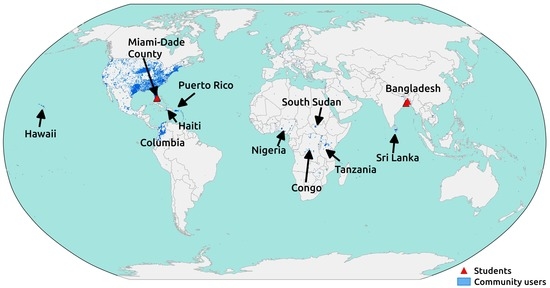OSM Data Import as an Outreach Tool to Trigger Community Growth? A Case Study in Miami
Abstract
:1. Introduction
2. Materials and Methods
2.1. Miami-Dade Large Building Import
- User logs on to TM
- User selects and locks an area to work on
- In TM, user loads current OSM data coverage into JOSM
- In TM, user loads import building dataset into JOSM
- In JOSM, user merges the import and OSM datasets into one single layer
- In JOSM, user works on resolving conflicts and refers to the tutorial if needed
- In JOSM, user runs the validation tool to ensure all data is correct and ready for upload
- User uploads data to OSM
- User marks TM task as “done” or unlocks it if task is unfinished
2.2. Outreach Techniques and Target Audiences
2.2.1. Students
2.2.2. Existing OSM Community and Local Community
3. Results
3.1. Participation Numbers
3.1.1. Students
3.1.2. Community Users
3.1.3. New and Existing Users
3.2. Mapping Behavior
3.2.1. Temporal Aspects
3.2.2. Spatial Aspects
3.2.3. Other OSM User Activities
4. Summary and Conclusions
Acknowledgments
Author Contributions
Conflicts of Interest
References
- Goodchild, M.F. Citizens as Voluntary Sensors: Spatial Data Infrastructure in the World of Web 2.0 (Editorial). Int. J. Spat. Data Infrastruct. Res. 2007, 2, 24–32. [Google Scholar]
- Haklay, M. Citizen Science and Volunteered Geographic Information: Overview and Typology of Participation. In Crowdsourcing Geographic Knowledge; Sui, D., Elwood, S., Goodchild, M., Eds.; Springer: Berlin, Germany, 2013; pp. 105–122. [Google Scholar]
- Goodchild, M.F.; Li, L. Assuring the quality of volunteered geographic information. Spat. Stat. 2012, 1, 110–120. [Google Scholar] [CrossRef]
- Haklay, M.; Weber, P. OpenStreetMap: User-Generated Street Maps. IEEE Pervas. Comput. 2008, 7, 12–18. [Google Scholar] [CrossRef]
- Hristova, D.; Quattrone, G.; Mashhadi, A.J.; Capra, L. The Life of the Party: Impact of Social Mapping in OpenStreetMap. In Proceedings of the Seventh International AAAI Conference on Weblogs and Social Media, Cambridge, MA, USA, 8–11 July 2013; pp. 234–243. [Google Scholar]
- Bryant, S.L.; Forte, A.; Bruckman, A. Becoming Wikipedian: Transformation of Participation in a Collaborative Online Encyclopedia. In Proceedings of the GROUP: International Conference on Supporting Group Work, Sanibel Island, FL, USA, 6–9 November 2005; pp. 1–10. [Google Scholar]
- Mooney, P.; Minghini, M.; Stanley-Jones, F. Observations on an OpenStreetMap mapping party organised as a social event during an open source GIS conference. Int. J. Spat. Data Infrastruct. Res. 2015, 10, 138–150. [Google Scholar]
- Mashhadi, A.; Quattrone, G.; Capra, L. The Impact of Society on Volunteered Geographic Information: The Case of OpenStreetMap. In OpenStreetMap in GIScience (Lecture Notes in Geoinformation and Cartography); Jokar Arsanjani, J., Zipf, A., Mooney, P., Helbich, M., Eds.; Springer: Berlin, Germany, 2015; pp. 125–141. [Google Scholar]
- Bégin, D.; Devillers, R.; Roche, S. Contributors’ Withdrawal from Online Collaborative Communities: The Case of OpenStreetMap. ISPRS Int. J. Geo-Inf. 2017, 6, 340. [Google Scholar] [CrossRef]
- Soden, R.; Palen, L. From crowdsourced mapping to community mapping: The post-earthquake work of OpenStreetMap Haiti. In Proceedings of the COOP 2014-Proceedings of the 11th International Conference on the Design of Cooperative Systems, Nice, France, 27–30 May 2014; pp. 311–326. [Google Scholar]
- Mooney, P.; Minghini, M. A Review of OpenStreetMap Data. In Mapping and the Citizen Sensor; Foody, G., See, L., Fritz, S., Mooney, P., Olteanu-Raimond, A.-M., Fonte, C.C., Antoniou, V., Eds.; Ubiquity Press: London, UK, 2017; pp. 37–59. [Google Scholar]
- OSM Wiki: Import Catalog. Available online: http://wiki.openstreetmap.org/wiki/Import/Catalogue (accessed on 20 January 2018).
- Zielstra, D.; Hochmair, H.H.; Neis, P. Assessing the effect of data imports on the completeness of OpenStreetMap—A United States case study. Trans. GIS 2013, 17, 315–334. [Google Scholar] [CrossRef]
- Mooney, P.; Corcoran, P. The annotation process in OpenStreetMap. Trans. GIS 2012, 16, 561–579. [Google Scholar] [CrossRef]
- Touya, G.; Brando-Escobar, C. Detecting level-of-detail inconsistencies in volunteered geographic information data sets. Cartographica 2013, 48, 134–143. [Google Scholar] [CrossRef]
- Beaulieu, A.; Bégin, D.; Genest, D. Community mapping and government mapping: Potential collaboration? In Proceedings of the Symposium of ISPRS Commission I, Calgary, AB, Canada, 15–18 June 2010; pp. 16–18. [Google Scholar]
- Fritz, S.; Linda, S.; Brovelli, M. Motivating and Sustaining Participation in VGI. In Mapping and the Citizen Sensor; Foody, G., See, L., Fritz, S., Mooney, P., Olteanu-Raimond, A.-M., Fonte, C.C., Antoniou, V., Eds.; Ubiquity Press: London, UK, 2017; pp. 93–117. [Google Scholar]
- Budhathoki, N.R.; Haythornthwaite, C. Motivation for open collaboration crowd and community models and the case of OpenStreetMap. Am. Behav. Sci. 2013, 57, 548–575. [Google Scholar] [CrossRef]
- Hecht, R.; Kunze, C.; Hahmann, S. Measuring completeness of building footprints in OpenStreetMap over space and time. ISPRS Int. J. Geo-Inf. 2013, 2, 1066–1091. [Google Scholar] [CrossRef]
- Fram, C.; Chistopoulou, K.; Ellul, C. Assessing the quality of OpenStreetMap building data and searching for a proxy variable to estimate OSM building data completeness. In Proceedings of the GIS Research UK (GISRUK) 2015 Proceedings, Leeds, UK, 15–17 April 2015; pp. 195–205. [Google Scholar]
- Brovelli, M.; Minghini, M.; Molinari, M.; Zamboni, G. Positional accuracy assessment of the OpenStreetMap buildings layer through automatic homologous pairs detection: The method and a case study. Int. Arch. Photogramm. Remote Sens. Spat. Inf. Sci. 2016, 41, 615. [Google Scholar] [CrossRef]
- Törnros, T.; Dorn, H.; Hahmann, S.; Zipf, A. Uncertainties of completeness measures in OpenStreetMap—A case study for buildings in a medium-sized German city. ISPRS Ann. Photogramm. Remote Sens. Spat. Inf. Sci. 2015, 2, 353–357. [Google Scholar] [CrossRef]
- Fan, H.; Zipf, A.; Fu, Q.; Neis, P. Quality assessment for building footprints data on OpenStreetMap. Int. J. Geogr. Inf. Sci. 2014, 28, 700–719. [Google Scholar] [CrossRef]
- Barron, C.; Neis, P.; Zipf, A. A comprehensive framework for intrinsic OpenStreetMap quality analysis. Trans. GIS 2014, 18, 877–895. [Google Scholar] [CrossRef]
- Juhász, L.; Hochmair, H.H. How do volunteer mappers use crowdsourced Mapillary street level images to enrich OpenStreetMap? In Proceedings of the 20th AGILE Conference on Geo-Information Science, Wageningen, The Netherlands, 18–21 Septermber 2017. [Google Scholar]
- Juhász, L.; Hochmair, H.H. Cross-Linkage Between Mapillary Street Level Photos and OSM Edits. In Geospatial Data in a Changing World: Selected papers of the 19th AGILE Conference on Geographic Information Science (Lecture Notes in Geoinformation and Cartography); Sarjakoski, T., Santos, M.Y., Sarjakoski, L.T., Eds.; Springer: Berlin, Germany, 2016; pp. 141–156. [Google Scholar]
- Elicker, J.D.; McConnell, N.L.; Hall, R.J. Research Participation for Course Credit in Introduction to Psychology: Why Don’t People Participate? Teach. Psychol. 2010, 37, 183–185. [Google Scholar] [CrossRef]
- Padilla-Walker, L.M.; Thompson, R.A.; Zamboanga, B.L.; Schmersal, L.A. Extra credit as incentive for voluntary research participation. Teach. Psychol. 2005, 32, 150–153. [Google Scholar] [CrossRef]
- Stephens, M. Gender and the GeoWeb: Divisions in the production of user-generated cartographic information. GeoJournal 2013, 78, 981–996. [Google Scholar] [CrossRef]
- Schmidt, M.; Klettner, S. Gender and experience-related motivators for contributing to openstreetmap. In Proceedings of the Action and Interaction in Volunteered Geographic Information (ACTIVITY) Workshop at AGILE 2013, Leuven, Belgium, 5 may 2013; pp. 13–18. [Google Scholar]
- Mooney, P.; Corcoran, P. Understanding the Roles of Communities in Volunteered Geographic Information Projects. In Progress in Location-Based Services (Lecture Notes in Geoinformation and Cartography); Krisp, J., Ed.; Springer: Berlin, Germany, 2013; pp. 357–371. [Google Scholar]
- Bégin, D.; Devillers, R.; Roche, S. Contributors’ enrollment in collaborative online communities: The case of OpenStreetMap. Geo-Spat. Inf. Sci. 2017, 20, 282–295. [Google Scholar] [CrossRef]
- Coleman, D.J.; Georgiadou, Y.; Labonte, J. Volunteered Geographic Information: The nature and motivation of produsers. Int. J. Spat. Data Infrastruct. Res. 2009, 4, 332–358. [Google Scholar]
- Napolitano, M.; Mooney, P. MVP OSM: A tool to identify areas of high quality contributor activity in OpenStreetMap. Bull. Soc. Cartogr. 2012, 45, 10–18. [Google Scholar]
- Burchfield, C.M.; Sappington, J. Compliance with required reading assignments. Teach. Psychol. 2000, 27, 59–60. [Google Scholar]
- Fernald, P.S. The Monte Carlo quiz: Encouraging punctual completion and deep processing of assigned readings. Coll. Teach. 2004, 52, 95–99. [Google Scholar]
- Nov, O. What motivates wikipedians? Commun. ACM 2007, 50, 60–64. [Google Scholar] [CrossRef]
- See, L.; Fritz, S.; Perger, C.; Schill, C.; McCallum, I.; Schepaschenko, D.; Duerauer, M.; Sturn, T.; Karner, M.; Kraxner, F. Harnessing the power of volunteers, the internet and Google Earth to collect and validate global spatial information using Geo-Wiki. Technol. Forecast. Soc. Chang. 2015, 98, 324–335. [Google Scholar] [CrossRef] [Green Version]
- Juhász, L.; Hochmair, H.H. Where to catch ‘em all?—A geographic analysis of Pokémon Go locations. Geo-Spat. Inf. Sci. 2017, 30, 241–251. [Google Scholar] [CrossRef]
- Choi, J.; Choi, H.; So, W.; Lee, J.; You, J. A Study about Designing Reward for Gamified Crowdsourcing System. In Design, User Experience, and Usability. User Experience Design for Diverse Interaction Platforms and Environments. DUXU 2014 (Lecture Notes in Computer Science, Vol. 8518); Marcus, A., Ed.; Springer: Cham, Switzerlands, 2014; pp. 678–687. [Google Scholar]
- Spiro, I. Motion chain: A webcam game for crowdsourcing gesture collection. In CHI’12 Extended Abstracts on Human Factors in Computing Systems; ACM: Austin, TX, USA, 2012; pp. 1345–1350. [Google Scholar]
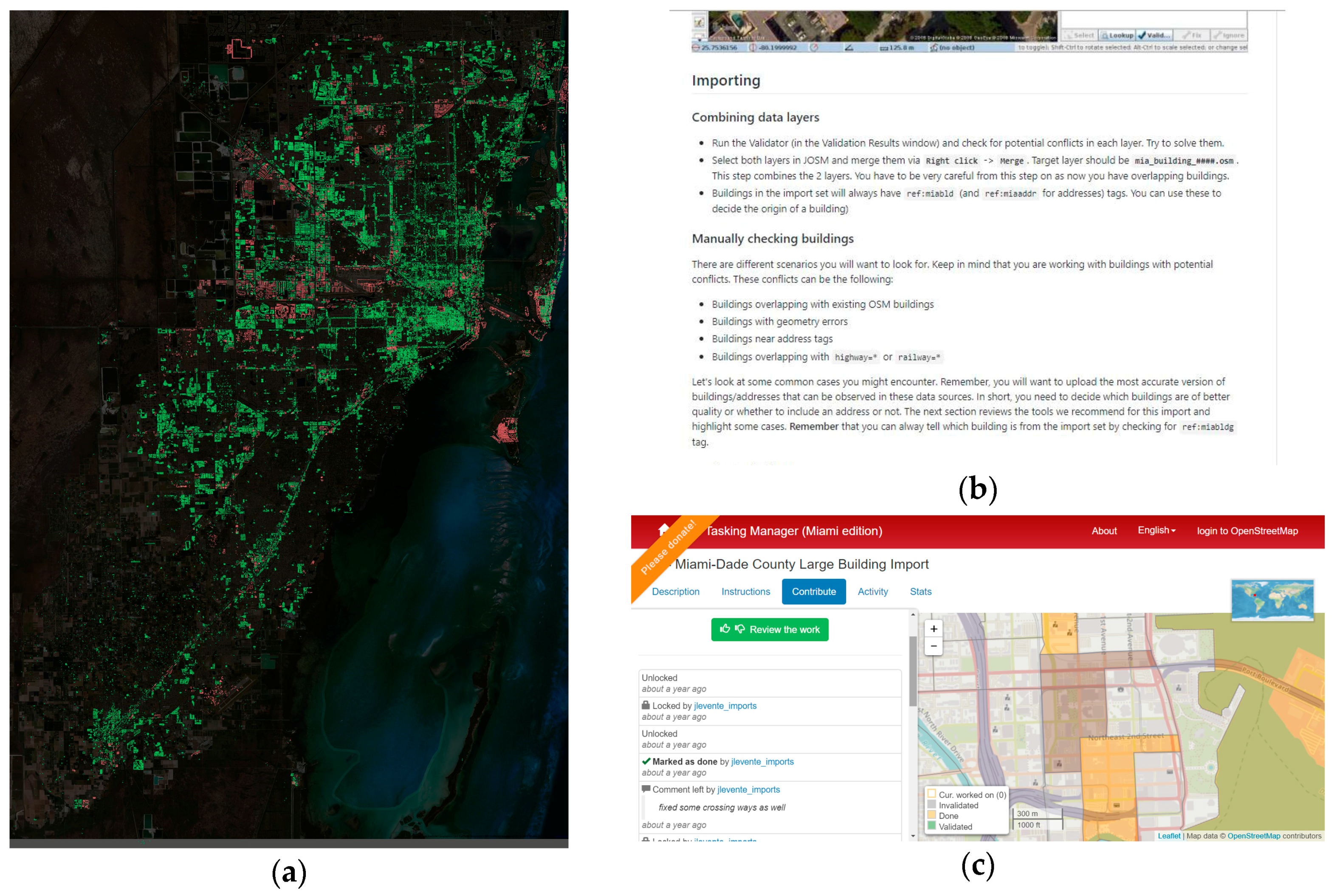
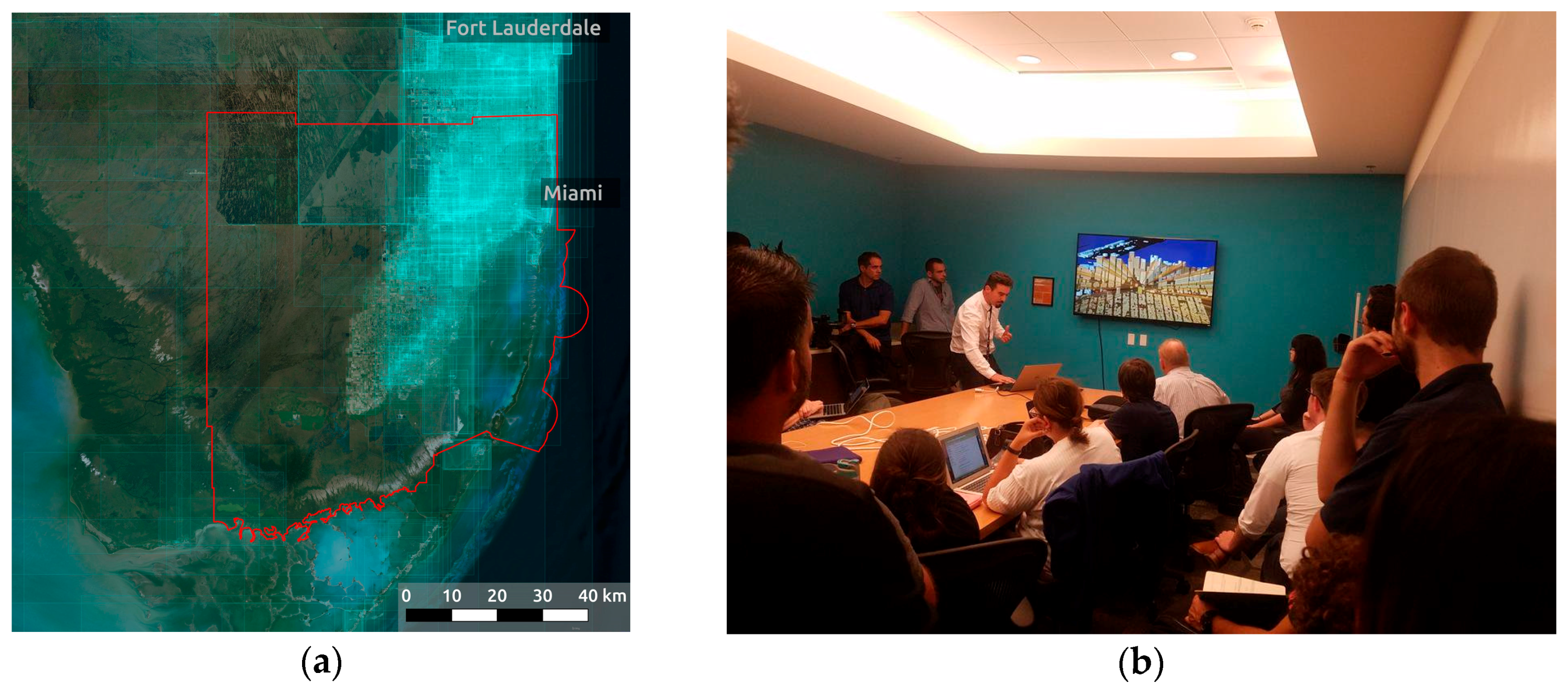
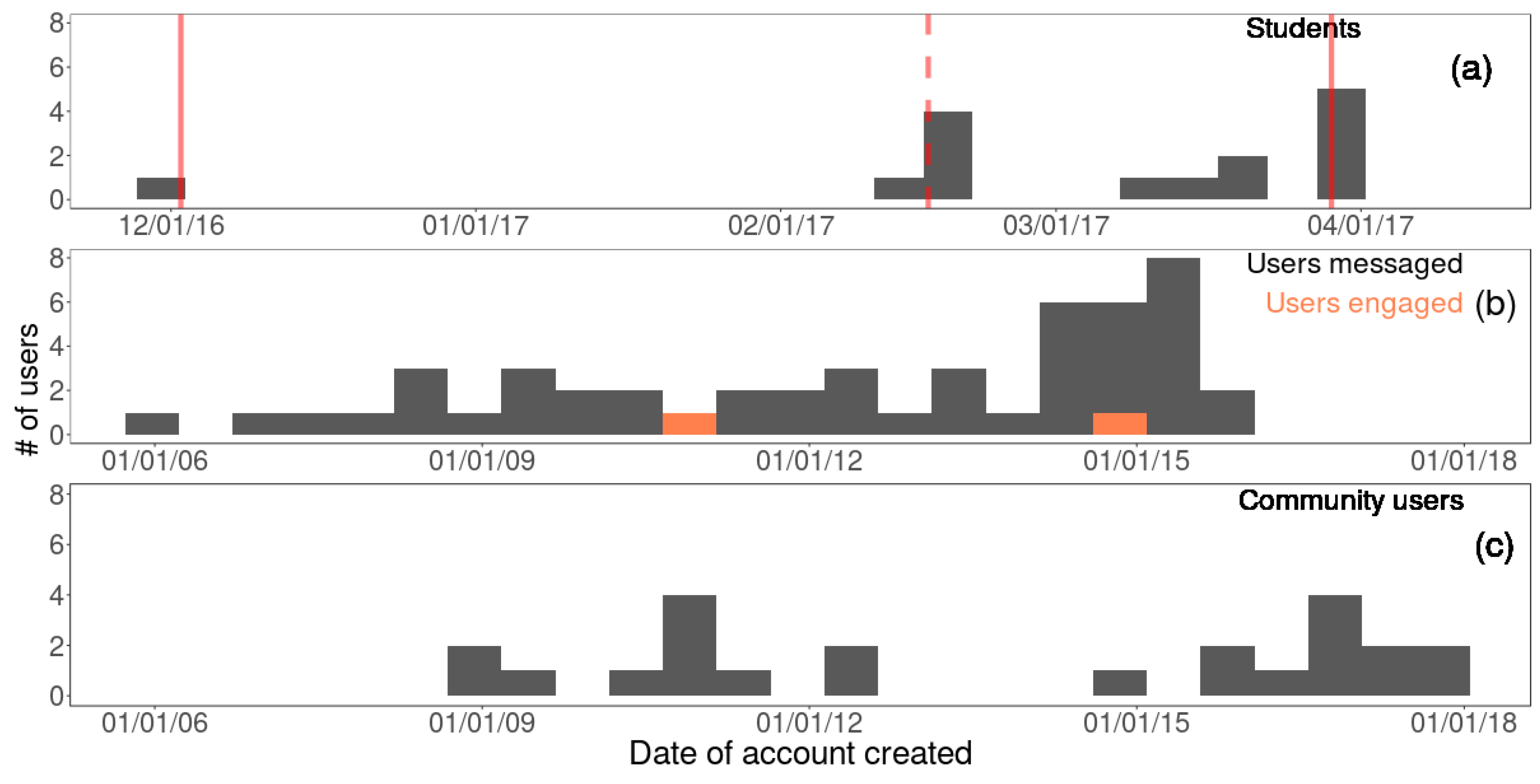
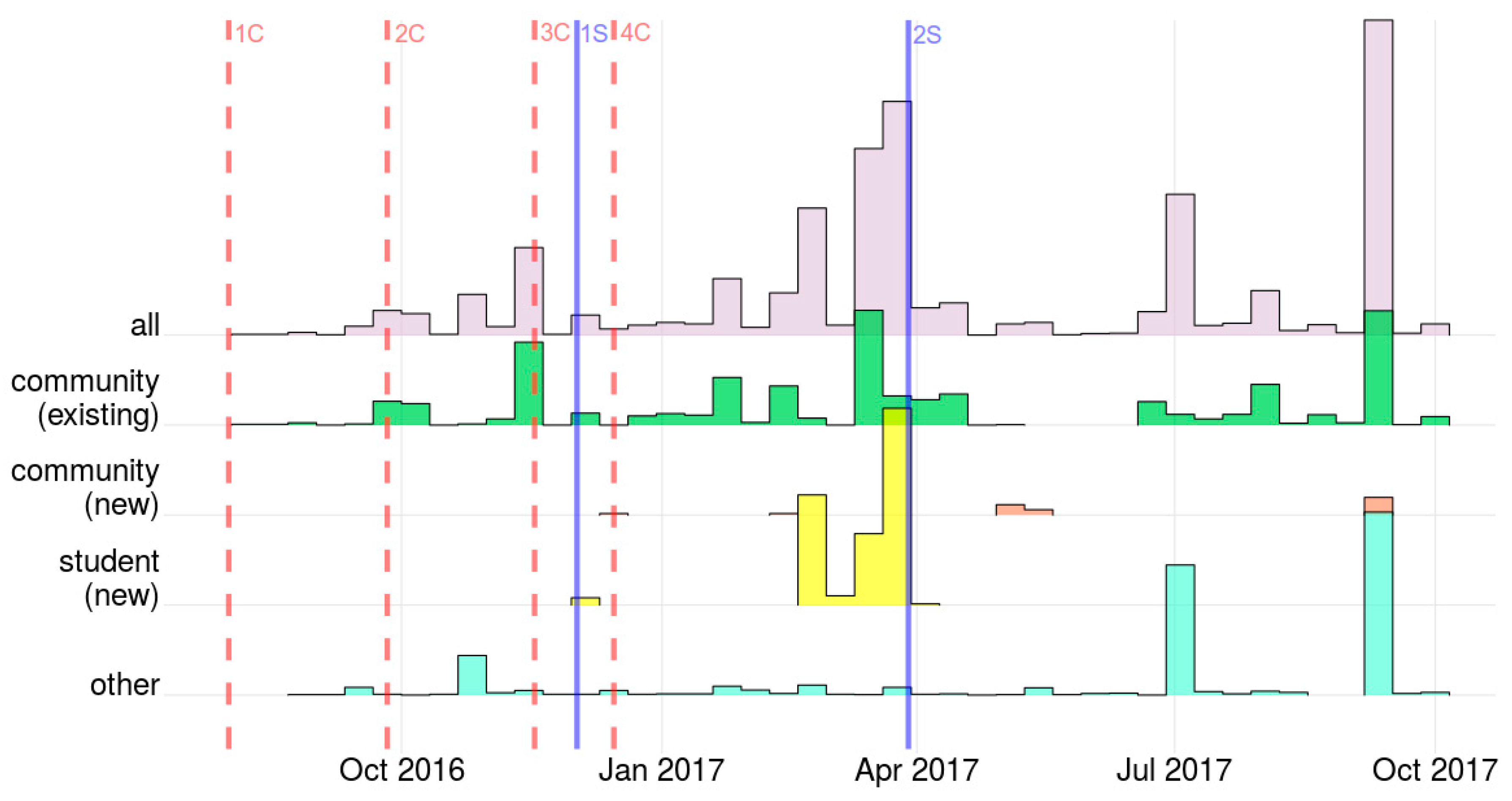
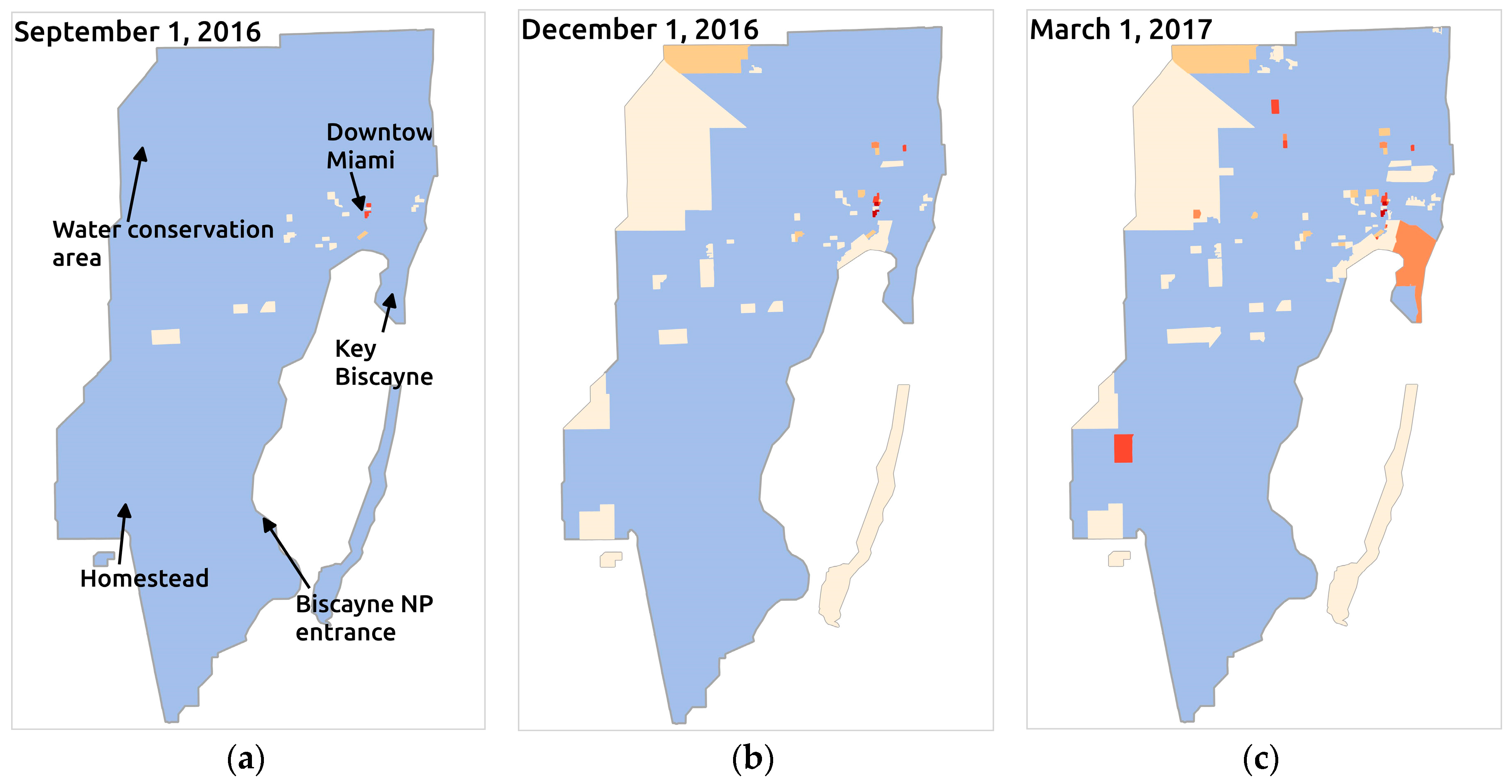
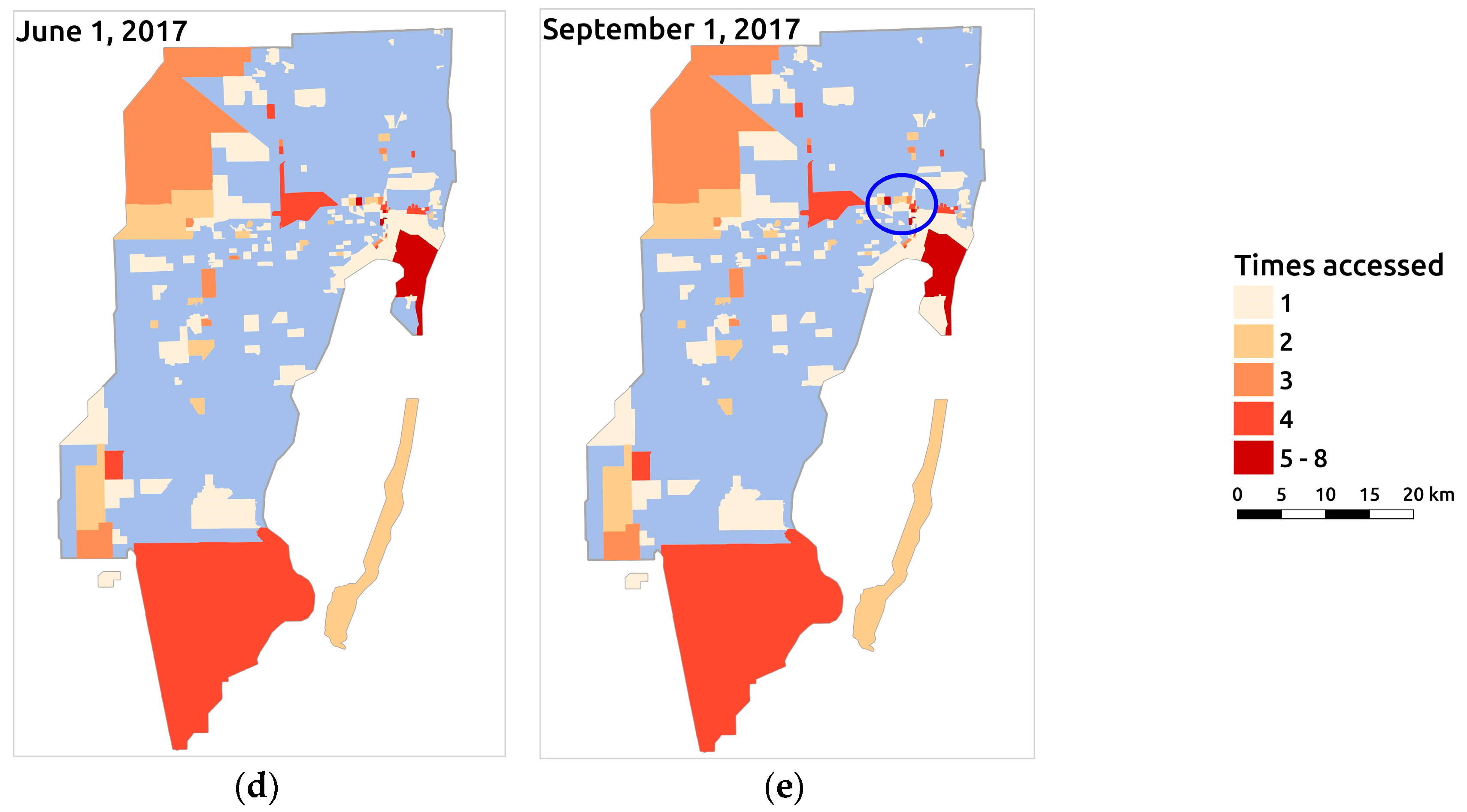

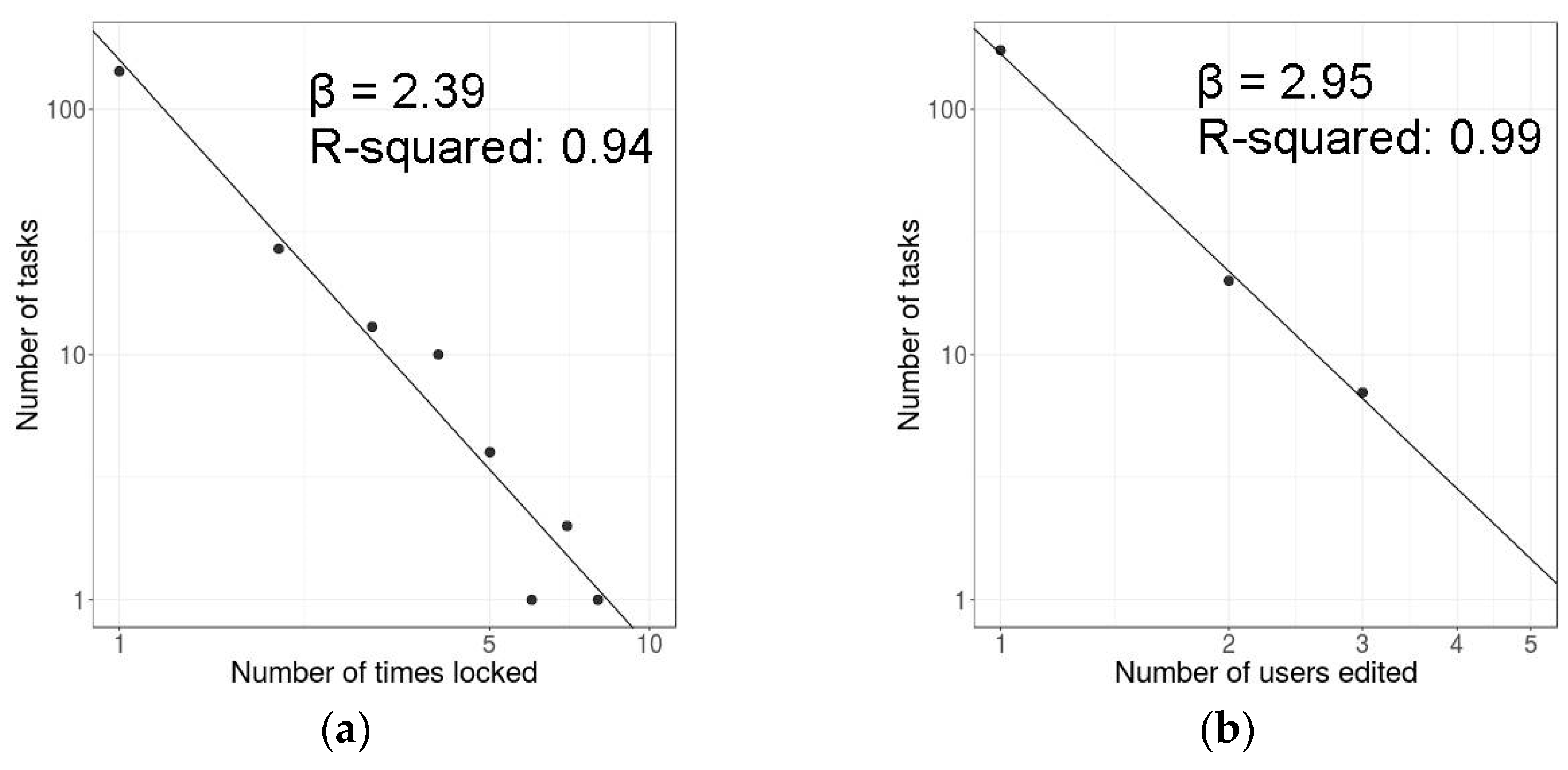

| Students(New) | Community Users | |||
|---|---|---|---|---|
| (New) | (Existing) | Total | ||
| N | 15 | 8 | 15 | 23 |
| Total # of buildings | 1554 | 69 | 1478 | 1547 |
| Average # of buildings per user | 103.6 | 8.7 | 98.5 | 67.2 |
| Median # of buildings per user | 87.0 | 3.5 | 24.0 | 16.0 |
| SD of # of buildings per user | 59.3 | 11.8 | 159.9 | 135.0 |
| Event | Event type | Event Description | Date |
|---|---|---|---|
| 1C | Community | Technical discussion of software tools, general information on the import, intro messages sent out | 1 August 2016 |
| 2C | Community | Presentation of automatic import results, hands-on mapping session | 26 September 2016 |
| 3C | Community | Hands on mapping session dedicated to the import | 17 November 2016 |
| 1S | Student | GIS Programming course bonus assignment due | 2 December 2016 |
| 4C | Community | Hands on mapping session dedicated to the import | 15 December 2016 |
| 2S | Student | GIS Analysis course bonus assignment due | 9 March 2017 |
© 2018 by the authors. Licensee MDPI, Basel, Switzerland. This article is an open access article distributed under the terms and conditions of the Creative Commons Attribution (CC BY) license (http://creativecommons.org/licenses/by/4.0/).
Share and Cite
Juhász, L.; Hochmair, H.H. OSM Data Import as an Outreach Tool to Trigger Community Growth? A Case Study in Miami. ISPRS Int. J. Geo-Inf. 2018, 7, 113. https://doi.org/10.3390/ijgi7030113
Juhász L, Hochmair HH. OSM Data Import as an Outreach Tool to Trigger Community Growth? A Case Study in Miami. ISPRS International Journal of Geo-Information. 2018; 7(3):113. https://doi.org/10.3390/ijgi7030113
Chicago/Turabian StyleJuhász, Levente, and Hartwig H. Hochmair. 2018. "OSM Data Import as an Outreach Tool to Trigger Community Growth? A Case Study in Miami" ISPRS International Journal of Geo-Information 7, no. 3: 113. https://doi.org/10.3390/ijgi7030113





